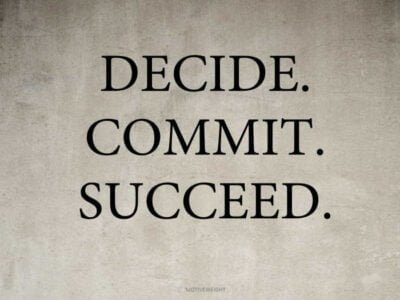Top 5 Steps to Effective Goal-Setting, 4 Simple Steps to Making Goals Work
Top 5 Steps to Effective Goal-Setting, 4 Simple Steps to Making Goals Work. What would you like to achieve in your lifetime? Author Basil S. Walth once said, “If you don’t know where you are going, how can you expect to get there?”
What would you like to achieve in your lifetime?
Author Basil S. Walth once said, “If you don’t know where you are going, how can you expect to get there?” These are words well spoken because whether you’re working toward freelancing full-time or selling your novels, you need a roadmap.
Goals are indispensable. They provide direction, long-term vision, and short-term motivation. They separate the important from the irrelevant. Goals also build self-confidence by helping you grow as an individual.
Olympic athletes, successful business people, and (hint…) bestselling writers are goal-setters. You aspire to greatness too, don’t you? If you do, and you’re not already setting goals, now is the perfect time to start.

5 Things to Remember When Setting Goals:
1. Write Goals Down
Always jotting down your goals-this is powerful. The process of physically seeing your goals helps crystallize them in your mind. This process also better enables you to commit to them.
Interesting Fact: A popular Harvard Business School study once found that only 3% of the population records their goals in writing. Another 14% have goals but don’t write them down, whereas 83% do not have clearly defined goals. More interesting is that this 3% earned an astounding ten times that of the 83% group!
2. Make Goals Short, Attainable, & Measurable
Set attainable short-term goals that can be measured. This means setting quantifiable goals.
Here are some examples:
- Commit to writing a certain number of words each week
- Submit at least two articles a week
- Find two new markets each week
- Take at least one writing course a year
- Attend at least one writer’s conference a year
Make your goals attainable so you won’t get discouraged. The short-term goals above are achievable for me, but they may not be for you. Or maybe for you, my short-term goals aren’t challenging enough.
Goals are very individual. You have to set your own goals, remember, you’re charting your own course to success!
On the other hand, don’t set wimpy goals simply because you’re afraid to fail. Talane Miedaner, author of Coach Yourself to Success (McGraw-Hill/Contemporary Books, 2002) notes: “People sometimes give themselves ‘weeny’ goals-they play it safe so they don’t fail…But the bigger the goal, the more likely you are to achieve it.”
3. Create Deadlines
Without deadlines, your goals are merely dreams. Set deadlines for both short- and long-term goals, and I promise, you’ll get there sooner!
Remember that deadlines can be flexible. Life changes and so do goals. Never be afraid to adjust the timeframe for a goal. What’s important is to keep moving forward.
4. Look at your goals every day!
Visual aids are an effective way to program your brain.
Reading and re-writing goals are two very effective visual aids. By physically rewriting your goals and pasting them in places you regularly frequent, you make them more accurate in your mind.
I read an article in this month’s Shape magazine that inspired me. The author mentioned that before Sarah Ban Breathnach, author of the bestselling book & Oprah Pick Simple Abundance: A Daybook of Comfort and Joy (Warner Books, 1995) became a bestselling author, she pasted her name on the #1 spot of the New York Times bestseller list and posted it on her computer. Visual Aids like these give you that extra ammunition that will make a difference.
5. Make Goal Setting a Routine
Begin every morning with a “Do” list. This will help you organize and better manage your time. Plus, your goals will be right smack under your nose every day. Do not get discouraged over any unfinished items. Simply transfer them to the next morning’s list.
The above said, keep your goals front and forward in your mind. Remember…you only get one chance to live your dreams!
In the words of Cecil B. De Mille: “The person who makes a success of living is the one who sees his goal steadily and aims for it unswervingly. That is dedication.”

4 Simple Steps to Making Goals Work
If you don’t establish a conscious direction you desire to move to, you may be moving in a direction you don’t want. Discover how to establish this crucial link.
You have heard it before. Goals are the secrets of the Champions. You have probably listed your goals as instructed by a book, an audio course, or a personal development trainer, but alas! The anticipated results weren’t yielded. Why.
Elite athletes and successful entrepreneurs dedicate their achievements to setting goals. Successful sportspersons/team managers/coaches have integrated goals into their coaching strategies. They tell us goal setting is a must; it works, full stop. So where do we go wrong?
Let’s explore this together in four simple but crucial steps. We are not going to go through the goal-setting techniques per se, we are just going to identify and fill in those missing links.
Step 1: Identify the Goal seeking
Ask yourself; what do you want? We, as human beings, are naturally goal-seeking. We move towards what preoccupies our minds, what we think of. As the famous aphorism goes; Energy follows thought.
If you don’t establish a conscious direction you desire to move to, you may be moving in a direction you don’t want. This might appear to be easy, but the fact is, very few people are clear about exactly what it is they want to achieve, and hence have got no conscious direction. They bump from wall to wall.
Set yourself apart from the majority of aimlessly drifting masses by knowing exactly what you want to achieve.
Step 2: Find the relationship between your goals and your values
Now, for the most powerful question, ask yourself why you want to achieve those particular goals.
Do you want a BMW? Why? You are saying it is because you have always loved big powerful luxurious cars? No, that is not the answer you are looking for. Is it status you are looking for, or make yourself attractive? No. all these are by-products of an underlying reason, I call them ‘conscious justifications’.
Now, ask yourself these essential questions:
How will it feel for you to own a big powerful luxurious brand new BMW? What will your emotional state being be like? Describe the feeling. Feel the feelings of achieving your goals. What is it that you are really after? Is it self-esteem, or self-confidence or are you looking for approval from societal pressures?
Take enough time to relate your goals with your deep-seated emotions so as to find congruence between your goals and your values as an individual, as this is the cornerstone of achieving your goals.
Your goals MUST match your individual values and they must start a ripple of desire to actualize them. If this won’t happen then you will end up ‘sabotaging’ them.
So, next time you want to keep those eyes on the prize, don’t just see yourself (visualize) ‘with your BMW’ getting excited, go deeper and feel the underlying emotions, the deep-seated reason, the sense of accomplishing a goal, the heightened self-esteem/self-confidence/self-efficacy; the reinforcement of your core individual values.
Step 3: Enhance the passion
Your goals must ignite the passion within you, the desire to reach them, and most importantly this passion, the yearning, must be constant. There are two basic ways to keep the hunger to reach your goals alive.
The first one is daily creative visualizations; the second is writing your goals and reading them at least twice a day. Once after you wake up and again before you go to bed. When you read or visualize your goals, incorporate the emotions that go with achieving your goals. Use anchoring to augment the effects.
Step 4: Experience your goals as being a reality
Every time you read or visualize your goals lives the experience of your goals is as if you have achieved them. This helps the mind to accept that what you tell it is true, and it will go to work to help you achieve your goals by programming the goals into your subconscious mind.
By following these four steps, you will condition your mind into accepting that your wishes are a reality and need to be actualized. Your subconscious mind will then go to work to pave the way for you. I highly recommend you visit www.acceleratedearning.com and look for the celebrated weekly success plan; it is one of the most complete, all-around self-development courses I have seen online. Sal Al-Rawahi www.acceleratedearning.com/
https://www.indeed.com/career-advice/career-development/thermometer-goal-chart
https://optimalhealth.in/how-to-be-successful-belief-and-success-5-keys/

